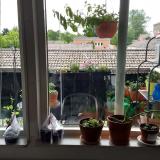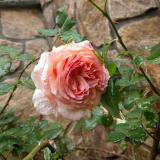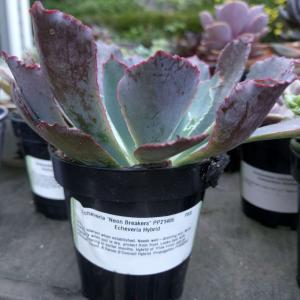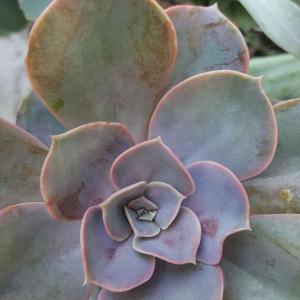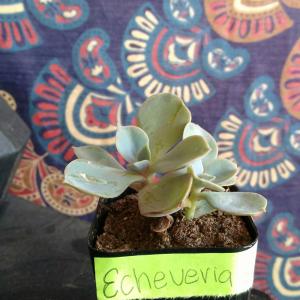Haleyfleeanne
2017年08月13日

Echeveria subessillis variagata
This particular plant needs more sun exposure but will have to be acclimated to prevent burn
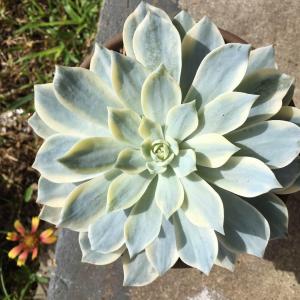
This particular plant needs more sun exposure but will have to be acclimated to prevent burn

0
0
成长记
SucculentLover021815
2017年08月11日

I new added a "Echeveria Perle Von Nurnberg" in my "garden"


0
0
成长记
Abby Gill
2017年08月10日

I new added a "Echeveria" in my "garden"
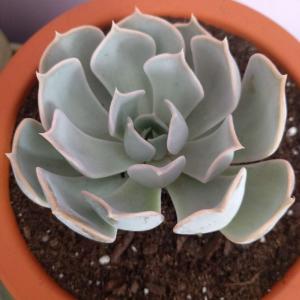

3
0
stureburk:I am very partial to Ikea-succulents but I've never found a echeveria there. Unless I'm completely mistaken it's a lilacina. :)
Lindsay
2017年08月10日

Echeveria Runyonii or Topsy Turvy has 3 stalks of blooms. The one on top of the pot.
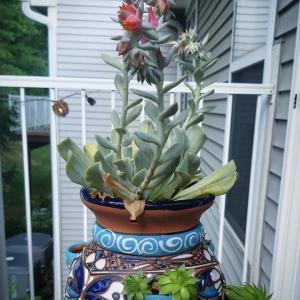
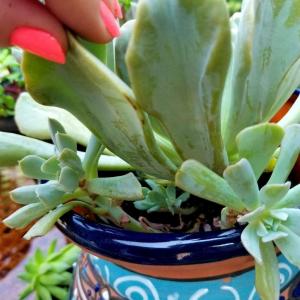
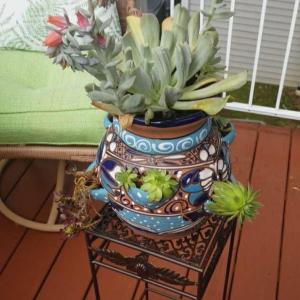
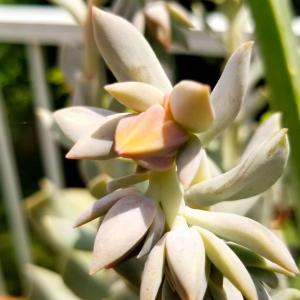




3
1
文章
Dummer. ゛☀
2017年08月04日

Haworthia are delightful little succulents that form very attractive and singular small houseplants. Generally easy to grow, the same best practices that yield healthy aloe and echeveria plants will also produce beautiful Haworthia.
In terms of appeal, these small, low growing plants form rosettes of fleshy green leaves that are generously covered with white, pearly warts or bands, giving them a distinctive appearance.
Just like other succulents, these plants appreciate bright light, adequate moisture in the summer, and relatively drier conditions in the winter. Don't overwater, but don’t also let them dry out too much.
Growing Conditions
Light: Bright light, but not direct sunlight. These grow in similar conditions to other succulents. White or yellow leaves usually signify too much sun.
Water: Water evenly and generously in the summer, letting the soil media dry out between waterings. In the winter, reduce watering to every other month. Never allow water to collect in the rosette.
Temperature: Warmer summers but cool in the winter (down to 50 degrees F).
Soil: Use a cactus mix or very fast-draining potting soil mixed with sand.
Fertilizer: Fertilize during the summer growing season with a cactus fertilizer. Don't feed during the winter.
Propagation
Haworthia can be propagated at repotting time using offsets from the mother plant.
When taking offsets, use a sharp knife or snippers and cut as close to the mother stem as possible to including as many roots as possible, then allow the offset to dry briefly before repotting it (similar to cuttings from other succulents). Pot the offsets in a small pot, using the same soil as the mother plant, put it a warm, bright spot, and make sure to adequately water.
Repotting
Haworthia are small (usually remaining between 3" and 5" in height) and relatively slow-growing. They are often grown in small clusters in wide, shallow dishes. Over time, clusters will naturally enlarge as the mother plant sends off small plantlets.
When the cluster has outgrown its dish, repot in the spring or early summer into a new wide and shallow dish with fresh potting soil. This is also the time to take offsets for propagation.
Varieties
There are about 80 species of Haworthia, but their classification can be complex. The main difference between the common species is the size of the leaves and the orientation of the white markings on the leaves. H. margaritifera has warty white projections on the leaves, while H. fasciata features horizontal white stripes and is sometimes called the zebra plant.
Some of the species, such as H. bolusii have "tufted" edges to the leaves, while H. attenuata features long, pointed green leaves. In general, the best advice is to buy the most attractive variety based on leaf form and markings—they all have similar cultural requirements.
Grower's Tips
Haworthia are not considered difficult houseplants to grow—if you can keep a pot of aloe alive on a windowsill, chances are you can do the same with a dish of Haworthia.
As with all succulents, the most dangerous situation is too much water—they should never be allowed to sit in water under any circumstances.
At the same time, these decorative little plants can be grown in interesting containers such as tea cups and even miniature baby shoes. If you're given a Haworthia in such a container, make sure the container had adequate drainage. If it doesn't, it might be a good idea to pop the plant out of its container and add a layer of gravel to the bottom to reduce the wicking action of the soil above.
Finally, look out for sunburned spots on your plants.
In terms of appeal, these small, low growing plants form rosettes of fleshy green leaves that are generously covered with white, pearly warts or bands, giving them a distinctive appearance.
Just like other succulents, these plants appreciate bright light, adequate moisture in the summer, and relatively drier conditions in the winter. Don't overwater, but don’t also let them dry out too much.

Growing Conditions
Light: Bright light, but not direct sunlight. These grow in similar conditions to other succulents. White or yellow leaves usually signify too much sun.
Water: Water evenly and generously in the summer, letting the soil media dry out between waterings. In the winter, reduce watering to every other month. Never allow water to collect in the rosette.
Temperature: Warmer summers but cool in the winter (down to 50 degrees F).
Soil: Use a cactus mix or very fast-draining potting soil mixed with sand.
Fertilizer: Fertilize during the summer growing season with a cactus fertilizer. Don't feed during the winter.
Propagation
Haworthia can be propagated at repotting time using offsets from the mother plant.
When taking offsets, use a sharp knife or snippers and cut as close to the mother stem as possible to including as many roots as possible, then allow the offset to dry briefly before repotting it (similar to cuttings from other succulents). Pot the offsets in a small pot, using the same soil as the mother plant, put it a warm, bright spot, and make sure to adequately water.
Repotting
Haworthia are small (usually remaining between 3" and 5" in height) and relatively slow-growing. They are often grown in small clusters in wide, shallow dishes. Over time, clusters will naturally enlarge as the mother plant sends off small plantlets.
When the cluster has outgrown its dish, repot in the spring or early summer into a new wide and shallow dish with fresh potting soil. This is also the time to take offsets for propagation.

Varieties
There are about 80 species of Haworthia, but their classification can be complex. The main difference between the common species is the size of the leaves and the orientation of the white markings on the leaves. H. margaritifera has warty white projections on the leaves, while H. fasciata features horizontal white stripes and is sometimes called the zebra plant.
Some of the species, such as H. bolusii have "tufted" edges to the leaves, while H. attenuata features long, pointed green leaves. In general, the best advice is to buy the most attractive variety based on leaf form and markings—they all have similar cultural requirements.

Grower's Tips
Haworthia are not considered difficult houseplants to grow—if you can keep a pot of aloe alive on a windowsill, chances are you can do the same with a dish of Haworthia.
As with all succulents, the most dangerous situation is too much water—they should never be allowed to sit in water under any circumstances.
At the same time, these decorative little plants can be grown in interesting containers such as tea cups and even miniature baby shoes. If you're given a Haworthia in such a container, make sure the container had adequate drainage. If it doesn't, it might be a good idea to pop the plant out of its container and add a layer of gravel to the bottom to reduce the wicking action of the soil above.
Finally, look out for sunburned spots on your plants.
2
6
文章
Dummer. ゛☀
2017年08月04日

Sempervivum, also known as “houseleeks” or “hen and chick” plants, are among the most popular succulents. They are exceptionally hardy plants and seem to thrive in cold and hot, low light or strong light. They are closely related to echeveria, kalanchoe, and crassula, which all belong to the Crassulaceae family. There is a very wide variety of sempervivum, and they are easily pressed into service as beautiful mixed-dish gardens.

Growing Conditions
Light: Full sun. Perfect for a sunny window.
Water: Water during the summer and spring, making sure drainage is immaculate. Reduce water in the winter to monthly.
Temperature: Prefers average summer temps (65ºF - 70ºF). In winter, some varieties can withstand temperatures down to freezing.
Soil: A well-drained succulent mix, with an ideal pH around 6.0 (slightly acidic).
Fertilizer: Feed with a controlled-release fertilizer in the beginning of the season or weekly with a weak liquid solution. Use a balanced 20-20-20 fertilizer at 1/4 strength on mature plants, and a fertilizer with less nitrogen on young plants.
Propagation
Sempervivum earned their popular name “hen and chicks” from their growth habit. The mother plant, or hen, sends off numerous offsets, which will cluster around her base like chicks. These offsets can be easily repotted, or the plants can be left to form a clumping mat.

Repotting
Repot as needed, preferably during the warm season. To repot a succulent, make sure the soil is dry before repotting, then gently remove the pot. Knock away the old soil from the roots, making sure to remove any rotted or dead roots in the process. Treat any cuts with a fungicide. Place the plant in its new pot and backfill with potting soil, spreading the roots out as you repot.
Leave the plant dry for a week or so, then begin to water lightly to reduce the risk of root rot.

Varieties
There are many hybrids and species of sempervivum, and they all feature similar growth habits. The most popular in the garden trade is the S. tectorum, which is a very attractive plant that grows in tight rosettes of plump leaves with red tips. Another sempervivum, the S. arachnoideum, appears to be coated in a fine web of hairs.
Grower's Tips
Sempervivum are not difficult to grow, provided they are not waterlogged and killed from excess watering. They can be easily grown outdoors and in containers, and they earned the name “houseleeks” from their tendency to root on the roofs of houses. After the mother plant flowers, it will naturally die, but by this time, the plant has likely produced many offsets that will continue to grow. These are excellent for cold windows.

Growing Conditions
Light: Full sun. Perfect for a sunny window.
Water: Water during the summer and spring, making sure drainage is immaculate. Reduce water in the winter to monthly.
Temperature: Prefers average summer temps (65ºF - 70ºF). In winter, some varieties can withstand temperatures down to freezing.
Soil: A well-drained succulent mix, with an ideal pH around 6.0 (slightly acidic).
Fertilizer: Feed with a controlled-release fertilizer in the beginning of the season or weekly with a weak liquid solution. Use a balanced 20-20-20 fertilizer at 1/4 strength on mature plants, and a fertilizer with less nitrogen on young plants.
Propagation
Sempervivum earned their popular name “hen and chicks” from their growth habit. The mother plant, or hen, sends off numerous offsets, which will cluster around her base like chicks. These offsets can be easily repotted, or the plants can be left to form a clumping mat.

Repotting
Repot as needed, preferably during the warm season. To repot a succulent, make sure the soil is dry before repotting, then gently remove the pot. Knock away the old soil from the roots, making sure to remove any rotted or dead roots in the process. Treat any cuts with a fungicide. Place the plant in its new pot and backfill with potting soil, spreading the roots out as you repot.
Leave the plant dry for a week or so, then begin to water lightly to reduce the risk of root rot.

Varieties
There are many hybrids and species of sempervivum, and they all feature similar growth habits. The most popular in the garden trade is the S. tectorum, which is a very attractive plant that grows in tight rosettes of plump leaves with red tips. Another sempervivum, the S. arachnoideum, appears to be coated in a fine web of hairs.
Grower's Tips
Sempervivum are not difficult to grow, provided they are not waterlogged and killed from excess watering. They can be easily grown outdoors and in containers, and they earned the name “houseleeks” from their tendency to root on the roofs of houses. After the mother plant flowers, it will naturally die, but by this time, the plant has likely produced many offsets that will continue to grow. These are excellent for cold windows.
0
1
文章
Dummer. ゛☀
2017年08月04日

Echeveria are very popular succulents that grow in attractive rosettes with beautiful leaves in a variety of colors and sometimes stunning flowers. These plants have been extensively hybridized, so in addition to the main species, there are many varieties that have been specially bred for interesting leaf form and color.
Most Echeveria will remain fairly small (a few inches to a foot across), but some species will grow to small shrub-like plants of 2 feet.
Members of the Crassulaceae family, their care is similar to sedum and kalanchoe succulents.

Growing Conditions
Light: Full sun. Perfect for a sunny window.
Water: Water during the summer and spring, making sure drainage is immaculate. Reduce water in the winter to monthly.
Temperature: Prefers average summer temps (65 degrees F - 70 degrees F). In winter, cool to 50 degrees F.
Soil: A well-drained succulent mix, with an ideal pH around 6.0 (slightly acidic).
Fertilizer: Feed with a controlled-release fertilizer in the beginning of the season or weekly with a weak liquid solution. Use a balanced 20-20-20 fertilizer at 1/4 strength on mature plants, and a fertilizer with less nitrogen on young plants.
Propagation
Most Echeveria can be easily propagated from leaf cuttings, although a few are better from seeds or stem cuttings. To propagate a leaf cutting, place the individual leaf in a succulent or cacti mix and cover the dish until the new plant sprouts.

Repotting
Repot as needed, preferably during the warm season. To repot a succulent, make sure the soil is dry before repotting, then gently remove the pot. Knock away the old soil from the roots, making sure to remove any rotted or dead roots in the process. Treat any cuts with a fungicide.
Place the plant in its new pot and backfill with potting soil, spreading the roots out as you repot.
Leave the plant dry for a week or so, then begin to water lightly to reduce the risk of root rot.
Varieties
There are many popular Echeveria, both species and hybrids. In nature, Echeveria are native to Mexico, the United States, and down into South America. Some of the more beautiful Echeveria include the blue Echeveria (E. glauca and E. laui), firecracker plant (E. setosa), painted lady (E. derenbergii), and E. agavoides.

Grower's Tips
Most of the common Echeveria species are not complicated succulents to grow, provided you follow a few basic rules. First, be careful never to let water sit in the rosette as it can cause rot or fungal diseases that will kill the plant.
Additionally, remove dead leaves from the bottom of the plant as it grows. These dead leaves provide a haven for pests, and Echeveria are susceptible to mealy bugs. As with all succulents, careful watering habits and plenty of light will help ensure success.
Most Echeveria will remain fairly small (a few inches to a foot across), but some species will grow to small shrub-like plants of 2 feet.
Members of the Crassulaceae family, their care is similar to sedum and kalanchoe succulents.

Growing Conditions
Light: Full sun. Perfect for a sunny window.
Water: Water during the summer and spring, making sure drainage is immaculate. Reduce water in the winter to monthly.
Temperature: Prefers average summer temps (65 degrees F - 70 degrees F). In winter, cool to 50 degrees F.
Soil: A well-drained succulent mix, with an ideal pH around 6.0 (slightly acidic).
Fertilizer: Feed with a controlled-release fertilizer in the beginning of the season or weekly with a weak liquid solution. Use a balanced 20-20-20 fertilizer at 1/4 strength on mature plants, and a fertilizer with less nitrogen on young plants.
Propagation
Most Echeveria can be easily propagated from leaf cuttings, although a few are better from seeds or stem cuttings. To propagate a leaf cutting, place the individual leaf in a succulent or cacti mix and cover the dish until the new plant sprouts.

Repotting
Repot as needed, preferably during the warm season. To repot a succulent, make sure the soil is dry before repotting, then gently remove the pot. Knock away the old soil from the roots, making sure to remove any rotted or dead roots in the process. Treat any cuts with a fungicide.
Place the plant in its new pot and backfill with potting soil, spreading the roots out as you repot.
Leave the plant dry for a week or so, then begin to water lightly to reduce the risk of root rot.
Varieties
There are many popular Echeveria, both species and hybrids. In nature, Echeveria are native to Mexico, the United States, and down into South America. Some of the more beautiful Echeveria include the blue Echeveria (E. glauca and E. laui), firecracker plant (E. setosa), painted lady (E. derenbergii), and E. agavoides.

Grower's Tips
Most of the common Echeveria species are not complicated succulents to grow, provided you follow a few basic rules. First, be careful never to let water sit in the rosette as it can cause rot or fungal diseases that will kill the plant.
Additionally, remove dead leaves from the bottom of the plant as it grows. These dead leaves provide a haven for pests, and Echeveria are susceptible to mealy bugs. As with all succulents, careful watering habits and plenty of light will help ensure success.
4
4


